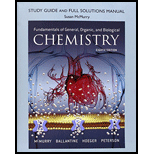
(a)
Interpretation:
The reason for why inhalation of
Concept Introduction:
Le Chatelier’s principle: If an equilibrium is disturbed by changing conditions, the system will moves the equilibrium to reverse the change.
Factor’s that effect chemical equilibria:
- Concentration – Equilibrium will be affected by changing the concentration of reactant or product. If we increase the concentration of reactant system will try to reverse the change by favoring forward reaction and thus increase the concentration of products. Likewise adding products increase yield of reactants.
- Temperature – When the temperature increases equilibrium will shift in the endothermic direction, in the direction that absorbs heat. When the temperature decreases equilibrium will shift in the exothermic direction, in the direction that releases heat.
- Pressure – If the reaction consists of only liquid and solid reactants and products, pressure has no effect in the equilibrium.
In gas reactions if the number of moles has no change then there will be no effect by pressure on equilibrium.
If pressure increases then equilibrium will shift to the direction having less number of molecules and if pressure decreases system will shift to the direction having more number of molecules.
(b)
Interpretation:
The reason for why pure oxygen is administrated to the victim of
Concept Introduction:
Le Chatelier’s principle: If an equilibrium is disturbed by changing conditions, the system will moves the equilibrium to reverse the change.
Factor’s that effect chemical equilibria:
- Concentration – Equilibrium will be affected by changing the concentration of reactant or product. If we increase the concentration of reactant system will try to reverse the change by favouring forward reaction and thus increase the concentration of products. Likewise adding products increase yield of reactants.
- Temperature – When the temperature increases equilibrium will shift in the endothermic direction, in the direction that absorbs heat. When the temperature decreases equilibrium will shift in the exothermic direction, in the direction that releases heat.
- Pressure – If the reaction consists of only liquid and solid reactants and products, pressure has no effect in the equilibrium.
In gas reactions if the number of moles has no change then there will be no effect by pressure on equilibrium.
If pressure increases then equilibrium will shift to the direction having less number of molecules and if pressure decreases system will shift to the direction having more number of molecules.
Want to see the full answer?
Check out a sample textbook solution
Chapter 7 Solutions
Study Guide And Full Solutions Manual For Fundamentals Of General, Organic, And Biological Chemistry
- Describe the relationship between the partial pressure of oxygen and the binding of oxygen to hemoglobin.arrow_forwardWhat are some advantages of gas exchange in air over gas exchange in water?arrow_forwardhow many moles of oxygen could be transported by the hemoglobin complex formed from 8 mg of dietary iron?arrow_forward
- The equation describing the linear relationship between hemoglobin concentration and absorbance at 520 nm is y=0.0523x+0.011. If the absorbance value is 0.6, calculate the % hemoglobin in whole blood.arrow_forwarda.What is the difference between the 5th and 6 coordination sites in the heme group? b.What is the change of the oxygen dissociation curve represented by hemoglobin before and after dissociation into subunits? Briefly explain why.arrow_forwardWhy do minute amounts of CO2 and CO impurities in a breathing mixture exert such profound physiologic effects?arrow_forward
- Which of the following statements about the oxygen-binding curves is FALSE?arrow_forwardScenario: In Charles’ blood, the partial pressure of CO in the blood (0.4 mm Hg) is far lower than the partial pressure of O2, yet the percent saturation of hemoglobin by each gas is approximately equal. What does this tell you about the affinity of hemoglobin for CO?arrow_forwardWhat is the physiological significance of the cooperative binding of oxygen by hemoglobin?arrow_forward
- Oxygen has an allosteric interaction with hemoglobin. What are the results of this interaction as oxygen a) binds to and b) is released from hemoglobin?arrow_forwarddefine the equilibrium constant KP for the chemical equilibrium ofideal-gas mixtures?arrow_forwardExplain, using Le Châtelier’s principle, why inhalation of CO can cause weakening and eventual death.arrow_forward
 Human Physiology: From Cells to Systems (MindTap ...BiologyISBN:9781285866932Author:Lauralee SherwoodPublisher:Cengage Learning
Human Physiology: From Cells to Systems (MindTap ...BiologyISBN:9781285866932Author:Lauralee SherwoodPublisher:Cengage Learning Anatomy & PhysiologyBiologyISBN:9781938168130Author:Kelly A. Young, James A. Wise, Peter DeSaix, Dean H. Kruse, Brandon Poe, Eddie Johnson, Jody E. Johnson, Oksana Korol, J. Gordon Betts, Mark WomblePublisher:OpenStax College
Anatomy & PhysiologyBiologyISBN:9781938168130Author:Kelly A. Young, James A. Wise, Peter DeSaix, Dean H. Kruse, Brandon Poe, Eddie Johnson, Jody E. Johnson, Oksana Korol, J. Gordon Betts, Mark WomblePublisher:OpenStax College Biology (MindTap Course List)BiologyISBN:9781337392938Author:Eldra Solomon, Charles Martin, Diana W. Martin, Linda R. BergPublisher:Cengage Learning
Biology (MindTap Course List)BiologyISBN:9781337392938Author:Eldra Solomon, Charles Martin, Diana W. Martin, Linda R. BergPublisher:Cengage Learning



